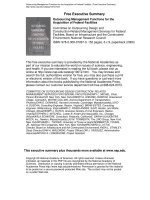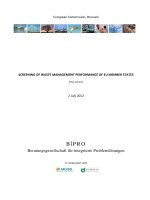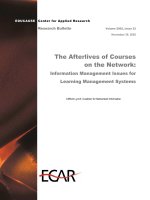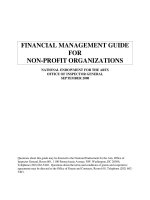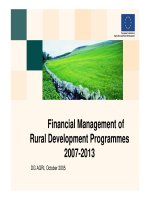FINANCIAL MANAGEMENT TOOLKIT FOR RECIPIENTS OF EU FUNDS FOR EXTERNAL ACTIONS pot
Bạn đang xem bản rút gọn của tài liệu. Xem và tải ngay bản đầy đủ của tài liệu tại đây (483.46 KB, 119 trang )
FINANCIAL MANAGEMENT TOOLKIT
FOR RECIPIENTS OF EU FUNDS FOR EXTERNAL ACTIONS
E u r o p e a n
Commission
Version 15 November 2010
Page 1
Page
► Introduction and Overview
2
► Module 1 - Internal Controls
10
► Module 2 - Documentation, Filing and Record Keeping
20
► Module 3 – Procurement
36
► Module 4 - Asset Management
48
► Module 5 - Payroll and Time Management
62
► Module 6 - Cash and Bank Management
76
► Module 7 - Accounting
86
► Module 8 - Financial Reporting
104
► Annex - Glossary of Terms
115
The Tools and Templates referred to in this toolkit are available at:
/>CONTENTS
CONTENTS
FINANCIAL MANAGEMENT TOOLKIT FOR RECIPIENTS OF EU FUNDS FOR EXTERNAL ACTIONS
Page 2
INTRODUCTION AND OVERVIEW
INTRODUCTION
AND OVERVIEW
FINANCIAL MANAGEMENT TOOLKIT FOR RECIPIENTS OF EU FUNDS FOR EXTERNAL ACTIONS
Page 3
INTRODUCTION AND OVERVIEW
PURPOSE OF THE TOOLKIT
This toolkit aims to help Recipients of EU funds for external
actions to comply with the conditions for financial management
set out in Contracts for EU-financed external actions.
Its specific objectives are to:
► provide basic, practical guidance in an easy-to-use format;
► raise awareness of existing EC Contractual Conditions;
► identify important risk areas, indicate what can go wrong and
explain how these risks can be avoided;
► provide best practices, tools and templates.
WHAT THE TOOLKIT IS NOT
The toolkit:
► is not a set of rules in addition to the existing legal,
contractual and regulatory framework and guides;
► is not a comprehensive manual of financial
management instructions. It does not guarantee
complete and accurate coverage of all existing
Contractual Conditions for financial management;
► is not an interpretation of the existing EC Contractual
Conditions;
► is not a substitute for reading the EC Contractual
Conditions and existing guides and instructions.
INTRODUCTION
►
The EC is not legally bound by the information contained in or omitted from this toolkit and does not accept any
liability in this respect.
► Only the Contractual Conditions and the relevant legal and regulatory framework which apply to the
implementation of a specific EU funded external action are binding. Recipients should obtain a sufficient
understanding of these.
► The names and descriptions in the real life stories have been changed to avoid disclosing the identities of the entity
or persons concerned. Any similarity with existing entities or persons is coincidental.
► All information in this toolkit is based on the 2009 release of the Commission’s contract models and guides.
Caution should be exercised in applying it to projects based on earlier contract models.
AND OVERVIEW
DISCLAIMERS
Page 4
Recipients of EU funds for external actions refers to organisations
that have signed a contract to receive EU funding.
The Recipient of EU funds is responsible for implementing the
contract, managing and using the EU funds and reporting on the
use of the funds.
Recipients of EU funds for external actions can be:
► Organisations (often NGOs) that have been awarded an EU
funded grant contract;
► Contractors for EU funded service contracts (often consultancy
and technical assistance firms);
► Contractors for EU funded works and supplies contracts;
► Governments of beneficiary states that have signed a financing
agreement with the EU on funding external actions (where the
financing agreement may include programme estimates) and
that may become Contracting Authorities themselves.
INTRODUCTION
USE OF THE TOOLKIT AND BASIC TERMS
This toolkit is for use by Recipients of EU funds for external actions.
AND OVERVIEW
► Contracting Authority refers to the authority that has
signed a contract for EU funding with a Recipient.
Depending on the ‘management mode’, (e.g. aid
may be centralised, decentralised or jointly managed
with international organisations) the Contracting
Authority may be the European Commission (“EC”),
a partner country, or an organisation to which the
EC has delegated implementation.
Where the EC is the Contracting Authority, it is usually
represented by EuropeAid or an EU Delegation.
INTRODUCTION AND OVERVIEW
Page 5
► ‘Contract’ can refer to any conventional or contractual
document signed by the Contracting Authority and a
Recipient which forms the specific legal basis for an EU
funded external action. The Annexes to the Contract also
form part of the Contract.
► Grants and service contracts are the commonest types of
contracts for EU funding of external actions.
► Programme estimates are another common way of
implementing external aid but they are not contracts in the
strict legal sense.
► These three way of implementing external actions will often
be mentioned in this toolkit. Other contract types are not
explicitly covered (i.e. works and supplies contracts,
contribution agreements with international organisations
and delegation agreements with national agencies).
► Contractual Conditions refer here to the conditions, rules,
and criteria which are set out in an EU-funded Contract for
external actions.
The terms “Recipient of EU funds for external actions”
(or “Recipient”), “Contract”, “Contractual Conditions” and
“Contracting Authority” are basic terms used throughout
this toolkit.
The rationale for this is that the toolkit aims to provide
basic guidance on financial management which can in
principle be used by any type of Recipient and for any type
of Contract, no matter who the Contracting Authority is.
INTRODUCTION
USE OF THE TOOLKIT AND BASIC TERMS (continued)
AND OVERVIEW
INTRODUCTION AND OVERVIEW
Page 6
ACCOUNTABILITY
By signing a Contract, Recipients accept responsibility and
accountability for:
► carrying out the action and managing and using EU funds in
compliance with the Contractual Conditions,
► sound financial management, and
► reporting on the action and on the use of EU funds to the
Contracting Authority.
The EC reserves the right to check that recipients meet their
obligations, by having audits and checks carried out by its own
staff or by professional audit firms. The European Court of
Auditors and the European Anti-Fraud Office (OLAF) may also
carry out audits or investigations.
Recipients are also accountable for any Contract for an EU
funded external action that they sign with a Contracting
Authority other than the EC. In such situations, the accountability
chain involves both the Recipient and the Contracting Authority,
which must report to the EC.
POSSIBLE CONSEQUENCES OF NOT MEETING
CONTRACTUAL OBLIGATIONS
If a Recipient fails to meet the Contractual Conditions it may
face serious consequences, such as:
► recovery by the Contracting Authority of funds relating to
unjustified or ineligible expenditure;
► additional audits or checks on other EU funded actions for
which it is responsible, or extrapolation of errors to those
actions, if its errors are systemic;
► sanctions, which may take the form of financial penalties
and/or termination of the contract.
If false declarations, substantial errors, irregularities or fraud
are found, the Recipient can be banned from all EU funded
contracts for up to 5 years. This may be extended to 10 years
for a repeat offence.
INTRODUCTION
AND OVERVIEW
INTRODUCTION AND OVERVIEW
Page 7
CONTENT OF THE TOOLKIT
This toolkit covers eight financial management areas:
► Module 1 - Internal Controls
► Module 2 - Documentation, Filing and Record Keeping
► Module 3 - Procurement
► Module 4 - Asset Management
► Module 5 - Payroll and Time Management
► Module 6 - Cash and Bank Management
► Module 7 - Accounting
► Module 8 - Financial Reporting.
INTRODUCTION
AND OVERVIEW
INTRODUCTION AND OVERVIEW
Page 8
The toolkit is available in printed (A5 “pocketbook”) and MS PowerPoint form.
► Printed copies of the toolkit can be obtained from EuropeAid Development and
Cooperation in Brussels, Belgium and from EU Delegations.
- To contact EuropeAid Development and Cooperation, see:
/>- To contact an EU Delegation, see:
/>► The toolkit can also be downloaded from EuropeAid’s website, at
/>HOW TO OBTAIN A COPY OF THE TOOLKIT
INTRODUCTION
AND OVERVIEW
TOOLS AND TEMPLATES
The tools (mainly checklists) and templates (e.g. the asset register, etc.)
to be used with this toolkit are provided at:
/>INTRODUCTION AND OVERVIEW
MODULE 1 - INTERNAL CONTROLS
Real life story
As Director of the Forestry Development Project of Syldavia, I was heading a team of agronomists responsible for EU funded activities.
The accounting records for our project were kept by the Project’s bookkeeper with the help of a junior administrative assistant.
My Deputy Director and myself fully trusted our bookkeeper. He was a very efficient, highly motivated individual. His deliverables
were always submitted well in time, and he required very little supervision from my Deputy Director or myself.
His tasks consisted of keeping the accounting records of the project and preparing the payment orders. He also kept the petty
cash and controlled the cheques and payments. In view of his high competence and trustworthyness, we had also granted him
a proxy signature on the bank account. He was a very conscientious accountant, who performed all cash and bank reconciliations
on a weekly basis.
After some 18 months of good service, he asked for a few days’ vacation, from which he never returned. We hired a replacement
bookkeeper, who discovered on his arrival that a very significant sum of money was missing from our bank account. We reported it
to the local police, who have not yet managed to locate our missing bookkeeper.
Lesson learnt: Had we segregated basic financial duties, the theft would most likely not have occurred…
MODULE 1
INTERNAL
CONTROLS
FINANCIAL MANAGEMENT TOOLKIT FOR RECIPIENTS OF EU FUNDS FOR EXTERNAL ACTIONS
Page 11
MODULE 1 - INTERNAL CONTROLS
Internal Control is designed to provide reasonable
assurance that operations are effective and
efficient, that financial information is reliable and
that the Contractual Conditions have been met.
If proper internal controls are not in place, there is
a high risk that EU funds will not be spent
efficiently and as agreed in the Contract. Project
assets may be lost and the use of funds may not
be properly accounted for.
WHY IS INTERNAL CONTROL A KEY FINANCIAL MANAGEMENT AREA?
Lack of adequate internal controls: a key risk
It is essential to have an internal control system
that provides reasonable assurance of achieving
the objectives.
MODULE 1
Content of this module
► Minimum contractual conditions.
► Basic tips.
► Specific issue - Importance of the internal control environment.
► Specific issue - Multilocation/multipartner projects.
► Tools and templates.
INTERNAL
CONTROLS
Key Message:
Better safe than
sorry: set up
internal
controls.
Page 12
Contracts for EU funded external actions do not include exhaustive internal control requirements. They do, however, contain certain
specific requirements which are internal control-related.
The main ones are:
MINIMUM CONTRACTUAL CONDITIONS
• Segregation of duties
between the authorising
and the
accounting officer
For programme estimates, the Practical Guide for Programme Estimates:
► requires the duties of the imprest administrator and the duties of the imprest accounting
officer to be kept separate (see “Roles and responsibilities” - Section 2.5);
► defines the roles and responsibilities of these two officers (see “The imprest administrator”
and “The imprest accounting officer”- Sections 2.5.1 and 2.5.2).
These requirements aim to segregate the duties of authorising expenditure and handling
payment (this is known as the ‘four eyes’ principle).
The Practical Guide for Programme Estimates can be found at:
/>Most Financing Agreements and Technical and Administrative Provisions require
authorisation and payment duties to be segregated.
• Prohibition of conflicts
of interest and
confidential payments
All Contracts for EU funded external actions prohibit conflicts of interest, confidential payments
(e.g. secret commissions, bribes) and other unethical practices.
MODULE 1
INTERNAL
CONTROLS
MODULE 1 - INTERNAL CONTROLS
Page 13
MINIMUM CONTRACTUAL CONDITIONS (continued)
• Regular checks In actions implemented through ‘delegated cooperation’ (for example contributions to
international organisations or delegation agreements with public sector bodies), the
Contract will generally require the delegatee to conduct regular checks to ensure that the
action has been implemented correctly.
• Measures to prevent
irregularities, fraud and
corruption
In actions implemented through ‘delegated cooperation’, the Contract will generally
require the delegatee to set up measures to prevent irregularities, fraud and corruption.
MODULE 1
INTERNAL
CONTROLS
MODULE 1 - INTERNAL CONTROLS
Page 14
Internal Control is an ongoing process which requires the continuous attention of management.
This section covers important, basic measures concerning control activities.
BASIC TIPS
A key measure is to ensure that no single
transaction or chain of transactions is in the
hands of a single person.
A transaction or chain of transactions may often
involve many different tasks. By assigning these
tasks to different people, Recipients will reduce
the risk of individuals being in a position to
commit fraud or conceal errors in the normal
course of their duties.
Examples of activities that can usefully be
segregated include:
► physical control of assets versus verification
tasks (for example, cash custody versus cash
reconciliation tasks);
► management tasks versus authorisation tasks
(for example, following procurement
procedures versus authorising the contract
with the supplier);
► management tasks versus accounting tasks
(for example, approving the purchase invoice
versus accounting for it);
► accounting tasks versus payment tasks
(for example, preparing payment versus signing
the bank transfer order).
MODULE 1
INTERNAL
CONTROLS
Key Message:
Ensure sufficient
segregation of
duties.
MODULE 1 - INTERNAL CONTROLS
Page 15
BASIC TIPS (continued)
There may be several ways of segregating tasks,
and some may be more effective than others.
It may be possible to organise the tasks so that
the individuals performing them will control
each other. This would enhance controls and
mitigate risks.
MODULE 1
INTERNAL
CONTROLS
Recipients should take the time to think about
the most effective way of segregating tasks,
depending on the nature of the project.
Appropriate authorisation procedures enhance
controls. Identify approval points that are relevant
to the project and assign responsibility for
carrying out such tasks to the most appropriate
individuals.
These individuals must understand that they are
responsible for checking anything they approve.
For example, for a service contract the team
leader may be asked to approve the timesheets
for the project staff.
Approval will usually be shown by the team
leader’s signature on the timesheets. However,
to provide effective control, the team leader
must effectively check the timesheets before
signing them.
Key Message:
Consider the most
effective way of
segregating
duties.
Key Message:
Foresee effective
approval points.
Approving
also means
checking.
MODULE 1 - INTERNAL CONTROLS
Page 16
BASIC TIPS (continued)
For the segregation of duties to work as
intended, every person concerned must
understand what his/her responsibilities are.
MODULE 1
INTERNAL
CONTROLS
To avoid misunderstandings, it is important to
describe all responsibilites and tasks in writing,
for example by means of:
► written job descriptions;
► a clear organisation chart, showing
responsibilities and tasks;
► descriptions (or flow-charts) of the intended
flow of transactions, indicating control points
and the frequency of controls.
An effective way to cover these topics is to put
them into a specially designed project or
programme manual.
Organisations with few staff may find it
difficult to segregate duties. However,
a minimum level of segregation (for example,
separation between the most important
functions such as authorisation and
accounting) is needed.
Sometimes only limited segregation of duties is
possible and economically feasible. Recipients
should compensate this by introducing a close
control and review system, run by management.
Key Message:
Staff must
understand their
responsibilities.
Key Message:
Small organisations
must also
segregate
duties and
controls.
MODULE 1 - INTERNAL CONTROLS
Page 17
SPECIFIC ISSUE - IMPORTANCE OF THE INTERNAL CONTROL
ENVIRONMENT
The primary foundation of a good internal control system is
the Recipient’s own internal environment, as set up by the
Recipient’s management.
This control environment includes:
► integrity, ethical values and the behaviour of key executives;
► management’s operating style;
► management’s commitment and competence;
► the organisational structure and assignment of responsibility
and authority;
► human resources policies and practices.
MODULE 1
INTERNAL
CONTROLS
By setting up the control environment, management “sets the
tone” of the entire organisation, influencing the control
consciousness of its staff. By promoting key values such as
integrity, ethics, transparency, competence and dedication to
good management practices, management provides a
framework for discipline and structure.
The internal control framework devised by the “Committee
on Sponsoring Organizations” of the Treadway Commission
(COSO) is currently the most widely accepted internal
control framework.
This framework identifies several layers and dimensions
of internal control:
► the internal control environment
► objective setting
► risk assessment and management
► control activities
► communications
► monitoring.
Information on the COSO internal control framework can
be obtained from: www.coso.org
MODULE 1 - INTERNAL CONTROLS
Page 18
SPECIFIC ISSUE - MULTILOCATION / MULTIPARTNER PROJECTS
In multilocation projects, the project is often carried out by
several independent partners, each with its own internal
control structure.
In such cases, a single entity will usually lead and coordinate the
entire project.
In Contracts for EU funded external actions, the lead entity will
usually be the main Recipient, which is considered responsible
for the entire project.
The lead (coordinating) entity in such a project will generally
be considered liable for poor execution of activities by the
project partners.
In order to mitigate this risk, the lead (coordinating)
Recipient should consider the following basic measures:
► at project design stage, evaluate whether the entities
taking part in the project have adequate internal
controls in place, in line with the general principles
outlined in this Module;
► during project execution, closely monitor the
performance of the project partners to ensure that their
internal controls remain adequate and that execution
remains under control;
► at regular intervals during the project, obtain copies
and / or review the accounting records and supporting
documents of those activities managed by participating
entities to ensure they meet the contractual conditions.
MODULE 1
INTERNAL
CONTROLS
MODULE 1 - INTERNAL CONTROLS
Page 19
Recipients are encouraged to use the Internal Control Checklist compiled with this toolkit.
Since internal control is an ongoing process, it is highly recommended that Recipients update their answers to the Internal Control
Checklist at regular intervals.
TOOLS AND TEMPLATES
MODULE 1
The following tool can be downloaded from the EuropeAid website at:
/>FMT - MODULE 1 - INTERNAL CONTROL CHECKLIST
INTERNAL
CONTROLS
MODULE 1 - INTERNAL CONTROLS
Page 20
MODULE 2 - DOCUMENTATION, FILING AND RECORD KEEPING
Real life story
The purpose of the project “Agricultural Development in San Theodoro Province” was to build grain storage silos in approximately
250 villages in the province.
During an audit launched by the Contracting Authority, the auditors found that the project’s accounting records, kept in the Recipient’s
offices in the provincial capital, were based on expense lists sent by the villages which summarised the quantities and cost of the
materials used. The supporting documents, however, were kept in each of the 250 villages.
The auditors also found that the supporting documents were archived in bags (several bags for each village). The documents in each
bag were not cross-referenced with the expense lists sent by the villages, nor were they filed in any way. Many supporting documents
for purchase of materials had been obtained from local suppliers, most of whom were very small, rural suppliers who did not draft valid
invoices or receipts.
What happened: The auditors submitted a disclaimer report to the Contracting Authority, indicating that the financial report for the
project was unverifiable, failing a proper audit trail and proper supporting documentation. As a result, the Contracting Authority
decided to terminate the contract.
MODULE 2
DOCUMENTATION
RECORD KEEPING
FINANCIAL MANAGEMENT TOOLKIT FOR RECIPIENTS OF EU FUNDS FOR EXTERNAL ACTIONS
Page 21
MODULE 2 - DOCUMENTATION, FILING AND RECORD KEEPING
For a Recipient, keeping clear and relevant
documentation is vital. Without proper
documentation, it is impossible to show that the
costs claimed from the Contracting Authority meet
the conditions of the Contract.
Approximately 4 out of 10 issues affecting project
funding found during audits under the EuropeAid
Audit Plan relate to inadequate record-keeping.
WHY IS DOCUMENTATION A KEY FINANCIAL MANAGEMENT AREA?
Lack of proper documentation; a key risk
If a Recipient cannot provide documentation
showing that the funds have been used in
accordance with the Contractual Conditions,
the Contracting Authority may decide to recover
the unsubstantiated expenditure.
Content of this module
► Minimum contractual conditions.
► What could go wrong? Key control measures.
► Basic tips.
► Specific issue - Multipartner/multilocation projects
► Specific issue - Difficult local environments
► Specific issue - Electronic documentation
► Tools and templates.
Key Message:
Not
documented,
Not eligible!
MODULE 2
DOCUMENTATION
RECORD KEEPING
Page 22
The following summarises the minimum contractual requirements for documentation and record keeping
in EU-funded external actions managed through grants, service contracts and programme estimates.
MINIMUM CONTRACTUAL CONDITIONS
• Grant Contracts The general conditions of grant contracts specify that:
► To be eligible, the costs must be identifiable and verifiable (Article 14).
• This means that there must be adequate documentation proving that any expenditure is
related to the project.
► The Recipient must allow the Contracting Authority to carry out checks and audits and to
examine supporting documents, accounting documents and any other documents
relevant to the financing of the project (Article 16(2)).
► The supporting documents and records must be kept available for inspection by the
Contracting Authority for up to seven years after the final balance of the grant is paid
(Article 16(2)).
► The supporting documents and records must be easily accessible and filed in a way that
facilitates examination (Article 16(2)).
► Certain documents must be kept (Article 16(3)): a list is given.
Key Message:
Understand the
Contractual
Conditions.
MODULE 2 - DOCUMENTATION, FILING AND RECORD KEEPING
MODULE 2
DOCUMENTATION
RECORD KEEPING
Page 23
MINIMUM CONTRACTUAL CONDITIONS (continued)
• Service Contracts The general conditions of service contracts state that:
► Full, accurate and systematic records and accounts must be kept to show the
actual days worked and the incidental expenditure incurred to provide the services
(Article 24(1)).
► For fee-based service contracts, timesheets recording the days or hours worked must
be kept (Article 24(2)).
► The records and documents must be kept available for inspection by the Contracting
Authority for seven years after final payment of the contract (Articles 24(3) and 25(1)).
► The documentation to be kept must include any documents needed to check
expenditure, such as timesheets, transportation tickets, boarding passes, pay slips and
invoices or receipts for incidental expenditure (Article 24(3)).
► Documents must be easily accessible and filed in a way that facilitates examination
(Article 25(2)).
MODULE 2 - DOCUMENTATION, FILING AND RECORD KEEPING
MODULE 2
DOCUMENTATION
RECORD KEEPING
Page 24
MINIMUM CONTRACTUAL CONDITIONS (continued)
• Programme Estimates
The Practical Guide for Programme Estimates gives:
► a list of the supporting documents required for the record of expenditure
(see “Documents making up a record of expenditure”, Section 4.1.3);
► an indicative list of the documents needed for payment files (see Annex 11, “Examples
of supporting documents by type of expenditure to be included in payment files”).
The Practical Guide for Programme Estimates can be found at:
/>The Financing Agreement usually requires all supporting documents to be kept available for
inspection by the Contracting Authority for seven years after final payment.
Recipients should consult the relevant Financing Agreement and Technical and Administrative
Provisions to check whether they contain any specific, additional requirements.
• Other contract types If the action is financed by means of some other type of contract, the Recipient should refer
to its provisions.
Most contracts include a general requirement that supporting documents and records be kept
available for inspection by the Contracting Authority for seven years after final payment.
MODULE 2 - DOCUMENTATION, FILING AND RECORD KEEPING
MODULE 2
DOCUMENTATION
RECORD KEEPING

